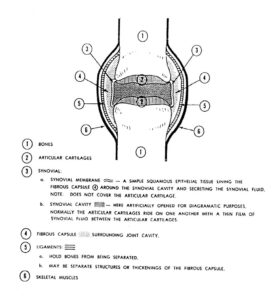1-11. DISLOCATIONS, SPRAINS, AND STRAINS
Dislocations, sprains, and strains are injuries to the musculoskeletal system. Although these injuries may not involve actual fractures, the causes, effects, and treatment of these injuries are closely related to those of fractures. Methods used to immobilize fractures are also used to immobilize dislocations and sprains.
1-12. DISLOCATIONS
A dislocation results when the end of a bone is moved from its normal articular position. The ligaments that hold the ends of the bones together may be torn. Other tissues surrounding the joint (the joint capsule) may also be injured (refer back to figure 1-2). Joints frequently affected include the shoulder, elbow, fingers, hips, and ankles.

a. Signs and Symptoms. A dislocation results in a deformed appearance due to the bone being out of its normal position. A dislocation also causes pain and/or a feeling of pressure over the joint. The region around the joint usually swells and is tender. The casualty may not be able to move the joint (the joint is “locked”). If the end of the dislocated bone is pressing on a nerve or blood vessel, the casualty may experience numbness or paralysis distal to (below) the injury.
CAUTION: Do not ask the casualty to move the injured body part in order to test for a locked joint or pain.
b. Treatment. Treat a dislocation as though it were a closed fracture.
(1) Immobilize the joint in the position in which the joint was found. Do not attempt to straighten or realign the bones.
(2) Reduce the swelling by elevating the joint and applying cold (a cold pack or ice compress, if available) to the joint for the first 24 hours after the musculoskeletal injury. After 24 hours, heat or warm soaks should be used to facilitate circulatory perfusion to the injured area.
(3) Check for pulse, strength, and sensation distal to the injury. If there is no pulse distal to the injury, attempt to restore blood circulation by gentle manipulation. If there is still no pulse, evacuate the casualty to a medical treatment facility as quickly as possible.
1-13. SPRAINS
A sprain results when the ligaments connecting two bones are stretched or torn. The other tissues that surround the joint may also be damaged. A sprain usually results when a joint is suddenly twisted beyond its normal range of motion. Skiing accidents often result in sprains. Sprains are most common in the knees and ankles. A sprain can result from a partial or temporary dislocation in which the bones resume their normal position following the injury. A sprain may produce as much damage as a dislocation.
a. Signs and Symptoms. A sprain does not cause a deformed appearance since the bones are not out of their normal positions. A sprain causes pain (tenderness), swelling, and discoloration (bruise) at the injured joint. The casualty may be unable to move the joint due to pain.
CAUTION: Do not ask the casualty to move the body part in order to test for inability to move the joint.
b. Treatment. Treat the sprain as though it were a closed fracture.
(1) Immobilize the joint.
(2) Reduce swelling by elevating the joint and applying cold, if available.
NOTE: Apply cold during the first 24 hours following the injury. After this time, apply warmth to the injured area.
1-14. STRAINS
A strain is a stretching or tearing of the muscle tissues around a joint. It is usually caused by excessive effort such as overstretching or overexertion. It is commonly called a “muscle pull.”
a. Signs and Symptoms. A strain does not result in a deformed appearance. Swelling may or may not be present. Muscle spasms may be present. A strain can cause pain when the joint is moved.
b. Treatment. Have the casualty avoid putting weight on the injured joint. If you are unsure whether the injury is a strain or sprain, treat it as a sprain.
